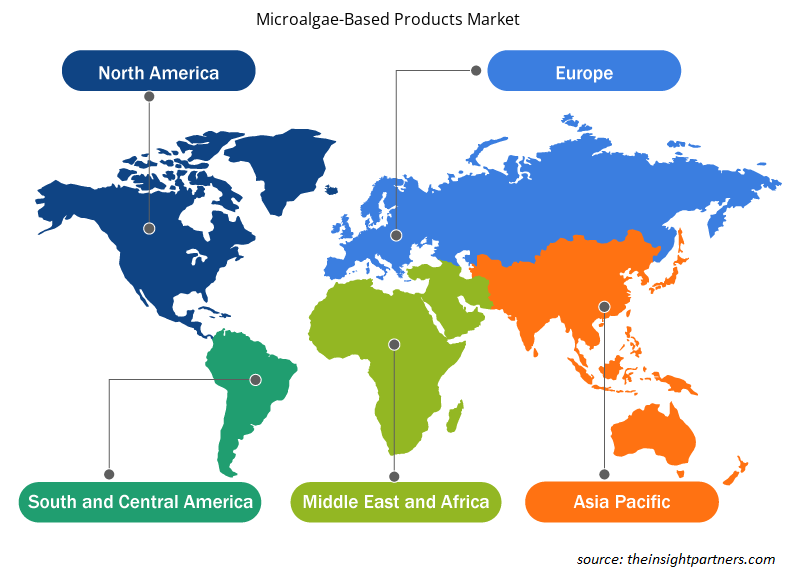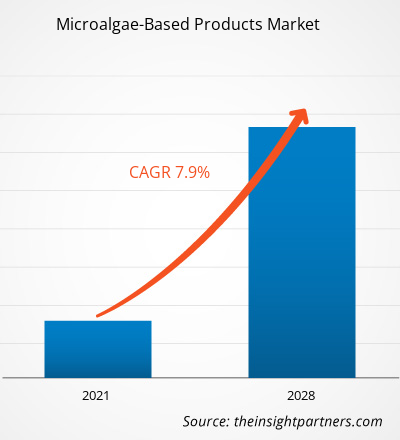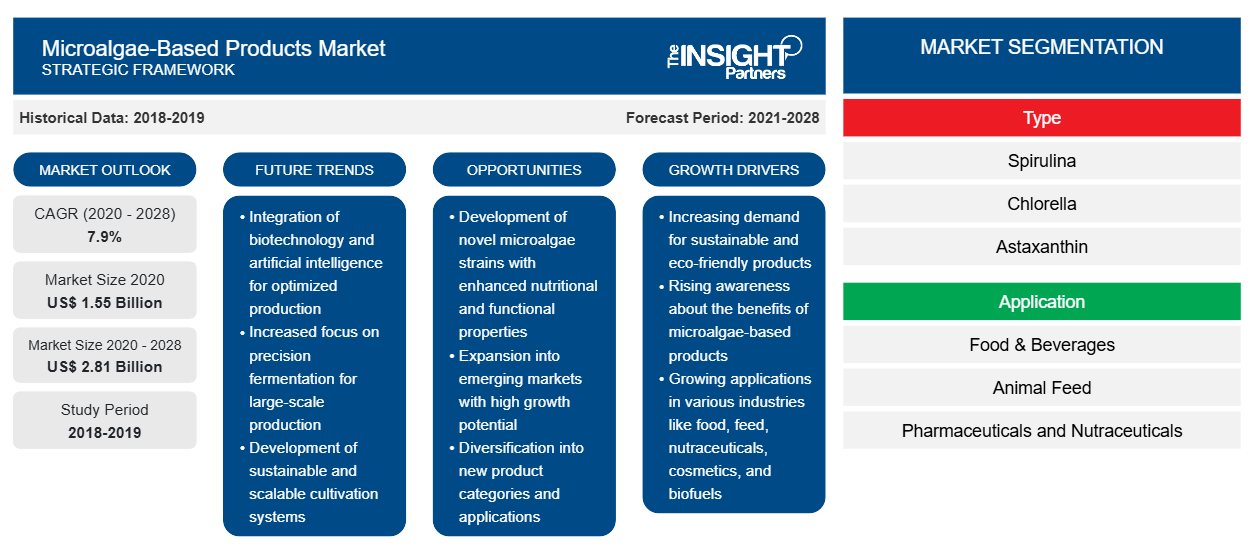Der Markt für Produkte auf Basis von Mikroalgen hatte im Jahr 2020 einen Wert von 1.547,23 Millionen US-Dollar und soll bis 2028 einen Wert von 2.811,10 Millionen US-Dollar erreichen; von 2021 bis 2028 wird mit einer durchschnittlichen jährlichen Wachstumsrate von 7,9 % gerechnet.
Mikroalgen sind prokaryotische oder eukaryotische Mikroorganismen, die mithilfe eines Mikroskops aufgespürt werden können. Diese mikroskopischen Organismen sind einzellige Arten, die einzeln oder in Ketten oder Gruppen vorkommen und in Süßwasser- und Meeressystemen vorkommen. Diese Mikroorganismen haben eine einfache Zellstruktur und benötigen für ihr Wachstum Licht, Kohlendioxid, Wasser und wichtige Nährstoffe wie Phosphor und Stickstoff. Außerdem sind Mikroalgen eine Quelle lebenswichtiger sekundärer Pflanzenstoffe wie Carotinoide , Ballaststoffe, Mineralien, Antioxidantien, Fettsäuren, Vitamine, halogenierte Verbindungen, Polysaccharide , Proteine und Lektine . Mikroalgen gelten als wertvolle Biomassequelle mit vielfältigem Potenzial in zahlreichen Branchen. Mikroalgen finden beispielsweise Anwendung in unterschiedlichen Endverbrauchsbranchen wie der Lebensmittel- und Getränkeindustrie, Tierernährung, Pharmazeutika und Nutraceutika sowie Körperpflege.
Im Jahr 2020 hatte Europa den größten Anteil am globalen Markt für mikroalgenbasierte Produkte . Die Dominanz des Marktes für mikroalgenbasierte Produkte in dieser Region ist in erster Linie auf das Vorhandensein einer starken industriellen Basis mit namhaften Herstellern von Arzneimitteln und Nutraceutika sowie verpackten Lebensmitteln und Getränken zurückzuführen. Die hohe Nachfrage nach mikroalgenbasierten Produkten aus verschiedenen Anwendungsbereichen wie Lebensmitteln und Getränken, Tierfutter, Arzneimitteln und Nutraceutika , Körperpflege, Chemikalien und Biokraftstoffen fördert das Marktwachstum in Europa. Steigende Investitionen in Anbautechnologien sowie ein zunehmender Fokus auf nachhaltige Lösungen bieten lukrative Möglichkeiten für das Wachstum des Marktes für mikroalgenbasierte Produkte in der Region.
Passen Sie diesen Bericht Ihren Anforderungen an
Sie erhalten kostenlose Anpassungen an jedem Bericht, einschließlich Teilen dieses Berichts oder einer Analyse auf Länderebene, eines Excel-Datenpakets sowie tolle Angebote und Rabatte für Start-ups und Universitäten.
-
Holen Sie sich die wichtigsten Markttrends aus diesem Bericht.Dieses KOSTENLOSE Beispiel umfasst eine Datenanalyse von Markttrends bis hin zu Schätzungen und Prognosen.
Auswirkungen der COVID-19-Pandemie auf den Markt für mikroalgenbasierte Produkte
Die anhaltende Pandemie hat den Status des Lebensmittel- und Getränkesektors drastisch verändert und sich negativ auf das Wachstum des Marktes für Produkte auf Mikroalgenbasis ausgewirkt . Die Umsetzung von Maßnahmen zur Bekämpfung der Ausbreitung des Virus hat die Situation verschärft und das Wachstum mehrerer Industriezweige beeinträchtigt. Der Markt wurde durch die plötzliche Verzerrung der Betriebseffizienz und Störungen der Wertschöpfungsketten beeinflusst, die auf die plötzliche Schließung nationaler und internationaler Grenzen zurückzuführen sind. Störungen bei der Beschaffung von Rohstoffen von Lieferanten und vorübergehende Schließungen von Produktionsstandorten aufgrund unbefristeter Sperrungen und Reisebeschränkungen haben das Wachstum des Marktes während der Pandemie beeinträchtigt. So sehr die Pandemie jedoch die Abläufe der Lieferketten beeinträchtigt hat, hat sie auch den Fokus der Verbraucher auf eine gesunde Lebensweise verlagert, wodurch die Verbraucher ihre Aufmerksamkeit auf nahrhafte Lebensmittel gerichtet haben. Darüber hinaus wird erwartet, dass die steigende Nachfrage nach Produkten auf Mikroalgenbasis in den Bereichen Lebensmittel und Getränke, Pharmazeutika und Nutrazeutika , Tierfutter und anderen Branchen sowie erhebliche Investitionen namhafter Hersteller den Markt für Produkte auf Mikroalgenbasis ankurbeln werden. Darüber hinaus wurden mehrere Anwendungen von Mikroalgen bei der Behandlung der COVID-19-Pandemie identifiziert. Eine im November 2020 von Frontiers Media SA veröffentlichte Studie zeigt beispielsweise die Wirksamkeit von aus Mikroalgen gewonnenen bioaktiven Metaboliten bei der Behandlung einer SARS-CoV-2-ähnlichen Virusinfektion.
Markteinblicke
Steigende Nachfrage nach Mikroalgen in pharmazeutischen und nutraceutischen Anwendungen
Produkte auf Basis von Mikroalgen haben den allgemein als sicher anerkannten ( GRAS ) Status erhalten, wodurch sie für pharmazeutische und nutraceutische Anwendungen geeignet sind. Mikroalgen sind für ihre antibakterielle, antioxidative, antivirale, antimalaria-, antimykotische , antitumorale und entzündungshemmende Wirkung bekannt. Sie sind eine Quelle lebenswichtiger sekundärer Pflanzenstoffe wie Carotinoide , Ballaststoffe, Mineralien, Antioxidantien, Fettsäuren, Vitamine, halogenierte Verbindungen, Polysaccharide sowie Lektine und andere Proteine. So sind die in Mikroalgen enthaltenen mehrfach ungesättigten Fettsäuren ( PUFA ) potenzielle Therapeutika, die auch das Risiko chronischer Erkrankungen wie Herz-Kreislauf-Erkrankungen, Diabetes, Alzheimer und Netzhautproblemen minimieren. Ebenso werden Cyanobakterien (Blaualgen) zunehmend bei der Synthese von Antibiotika und pharmakologisch aktiven Verbindungen eingesetzt. Ebenso wurde die Verwendung von Cyanobakterien (Blaualgen) auf die Herstellung von Antibiotika und pharmakologisch aktiven Verbindungen ausgeweitet. Mehrere Forschungsstudien betonen auch die Bedeutung der Einnahme von Chlorella -Tabletten bei der Behandlung von Übelkeit, Erbrechen und anderen Magen-Darm-Problemen. Ebenso hilft Carrageen aus Rotalgen bei der Behandlung des Grippevirus. Algen gelten auch als wichtige Quelle für pharmakologisch aktive Naturprodukte und Nutraceuticals . Die aus verschiedenen Algenvarianten gewonnenen Naturprodukte dienen als Grundlage für die Arzneimittelentdeckung und finden Anwendung bei der Formulierung von Medikamenten. Die potenzielle Anwendung von Mikroalgen wurde auch in der Nutraceutical- Industrie festgestellt. Derzeit ist der Wert von Nutraceuticals, die aus Algenbiomasse gewonnen werden, auf dem Markt sehr hoch. Mikroalgen können in erheblichem Maße bei der Herstellung von Nahrungsergänzungsmitteln, diätetischen Ergänzungsmitteln und höherwertigen verarbeiteten Lebensmitteln sowie Nicht-Nahrungsergänzungsmitteln wie Tabletten und Weichkapseln verwendet werden. Beispielsweise werden Mikroalgen aus Chlorella , Dunaliella , Haematococcus , Spirulina und Aphanizomenon häufig zur Herstellung von Nahrungsergänzungsmitteln verwendet. Daher steigt die Nachfrage nach Mikroalgen in der Pharma- undAnwendungsgrundlagen für Nutraceuticals .
Typ-Einblicke
Je nach Typ ist der Markt für Produkte auf Basis von Mikroalgen in Spirulina , Chlorella , Astaxanthin , Beta-Carotin und andere unterteilt. Im Jahr 2020 dominierte das Spirulina -Segment den globalen Markt für Produkte auf Basis von Mikroalgen . Spirulina ist definiert als prokaryotisches Cyanobakterium , das für vielfältige Anwendungsbereiche wie Aquakultur, Pharmazeutika und Nutraceutika sowie Lebensmittelfarben hergestellt wird. Die Mikroalgen bestehen zu 60–70 % aus Proteinen, darunter Aminosäuren wie Leucin, Isoleucin und Valin , sowie anderen essentiellen Mineralstoffen wie Beta-Carotin, B-Vitaminen, Phycocyanin , Chlorophyll und Vitamin E. Das Nährwertprofil der Algen macht sie zu einer idealen Zutat für verschiedene Anwendungsbereiche. Spirulina- Algen gelten als Superfood und werden in großem Umfang gezüchtet, um die steigende Nachfrage in diversen Endverbrauchsbranchen zu decken.
Anwendungseinblicke
Basierend auf der Anwendung ist der Markt für Produkte auf Mikroalgenbasis in Lebensmittel und Getränke, Tierfutter, Arzneimittel und Nutraceutika, Körperpflege und andere unterteilt. Das Segment Arzneimittel und Nutraceutika hatte im Jahr 2020 den größten Marktanteil. Mikroalgen gelten als eine der erneuerbaren Quellen für pharmazeutische Verbindungen und werden als allgemein als sicher anerkannte (GRAS) Verbindungen eingestuft, die sich ideal für den Einsatz in der Pharmaindustrie eignen. Mikroalgen werden in erheblichem Maße bei der Formulierung von Krebsmedikamenten verwendet – einer Verbindung namens Cryptophyci. Darüber hinaus werden sie aufgrund ihrer entzündungshemmenden und krebshemmenden Eigenschaften auch zur Herstellung alkaloidaler Neurotoxine wie Saxitoxin und Polyketid verwendet. In ähnlicher Weise werden Mikroalgen wie Chlorella, Dunaliella, Haematococcus, Spirulina und Aphanizomenon häufig bei der Formulierung von Nahrungsergänzungsmitteln verwendet.
Zu den wichtigsten Akteuren auf dem Markt für mikroalgenbasierte Produkte gehören Algae Health Sciences – ein BGG-Unternehmen; Cargill Inc.; Cellana Inc.; und Cyanotech Corporation. Die wichtigsten Unternehmen führen Fusionen und Übernahmen sowie F&E-Strategien durch, um ihren Kundenstamm zu erweitern und Marktanteile auf dem globalen Markt für mikroalgenbasierte Produkte zu gewinnen, was ihnen ermöglichen würde, die Reichweite ihres Markennamens zu erhöhen.
Bericht-Spotlights
- Fortschrittliche Branchentrends auf dem Markt für Mikroalgenprodukte helfen den Akteuren bei der Entwicklung wirksamer langfristiger Strategien
- In Industrie- und Entwicklungsländern angewandte Strategien für Unternehmenswachstum
- Quantitative Analyse des Marktes für Mikroalgenprodukte von 2019 bis 2028
- Schätzung der weltweiten Nachfrage nach Mikroalgenprodukten
- PEST-Analyse zur Veranschaulichung der Wirksamkeit der in der Branche tätigen Käufer und Lieferanten
- Aktuelle Entwicklungen zum Verständnis des wettbewerbsorientierten Marktszenarios
- Markttrends und -aussichten sowie Faktoren, die das Wachstum des Marktes für Mikroalgenprodukte vorantreiben und bremsen
- Unterstützung im Entscheidungsprozess durch Aufzeigen von Marktstrategien, die das kommerzielle Interesse untermauern und zum Marktwachstum führen
- Größe des Marktes für Mikroalgenprodukte an verschiedenen Knotenpunkten
- Detaillierte Übersicht und Segmentierung des Marktes sowie der Dynamik der Mikroalgen-basierten Produkte
- Größe des Marktes für Mikroalgenprodukte in verschiedenen Regionen mit vielversprechenden Wachstumschancen
Auf der Grundlage des Typs wurde der globale Markt für Produkte auf Mikroalgenbasis in Spirulina, Chlorella, Astaxanthin, Beta-Carotin und andere unterteilt.
Auf Grundlage der Anwendung wurde der globale Markt für Produkte auf Mikroalgenbasis in die Bereiche Nahrungsmittel und Getränke, Tierfutter, Pharmazeutika und Nutraceutika, Körperpflege und Sonstiges segmentiert.
Regionale Einblicke in den Markt für Produkte auf Mikroalgenbasis
Die regionalen Trends und Faktoren, die den Markt für mikroalgenbasierte Produkte während des gesamten Prognosezeitraums beeinflussen, wurden von den Analysten von Insight Partners ausführlich erläutert. In diesem Abschnitt werden auch die Marktsegmente und die Geografie für mikroalgenbasierte Produkte in Nordamerika, Europa, im asiatisch-pazifischen Raum, im Nahen Osten und Afrika sowie in Süd- und Mittelamerika erörtert.

- Erhalten Sie regionale Daten zum Markt für Mikroalgenprodukte
Umfang des Marktberichts zu Produkten auf Mikroalgenbasis
| Berichtsattribut | Details |
|---|---|
| Marktgröße im Jahr 2020 | 1,55 Milliarden US-Dollar |
| Marktgröße bis 2028 | 2,81 Milliarden US-Dollar |
| Globale CAGR (2020 - 2028) | 7,9 % |
| Historische Daten | 2018-2019 |
| Prognosezeitraum | 2021-2028 |
| Abgedeckte Segmente |
Nach Typ
|
| Abgedeckte Regionen und Länder |
Nordamerika
|
| Marktführer und wichtige Unternehmensprofile |
|
Dichte der Marktteilnehmer auf Mikroalgenbasis: Auswirkungen auf die Geschäftsdynamik verstehen
Der Markt für Produkte auf Mikroalgenbasis wächst rasant, angetrieben durch die steigende Nachfrage der Endverbraucher aufgrund von Faktoren wie sich entwickelnden Verbraucherpräferenzen, technologischen Fortschritten und einem größeren Bewusstsein für die Vorteile des Produkts. Mit steigender Nachfrage erweitern Unternehmen ihr Angebot, entwickeln Innovationen, um die Bedürfnisse der Verbraucher zu erfüllen, und nutzen neue Trends, was das Marktwachstum weiter ankurbelt.
Die Marktteilnehmerdichte bezieht sich auf die Verteilung der Firmen oder Unternehmen, die in einem bestimmten Markt oder einer bestimmten Branche tätig sind. Sie gibt an, wie viele Wettbewerber (Marktteilnehmer) in einem bestimmten Marktraum im Verhältnis zu seiner Größe oder seinem gesamten Marktwert präsent sind.
Die wichtigsten auf dem Markt für auf Mikroalgen basierende Produkte tätigen Unternehmen sind:
- Algae Health Sciences – Ein Unternehmen der BGG
- Astareal Ab
- Bluebiotech International Gmbh
- Cargill, Incorporated
- Cellana Inc.
Haftungsausschluss : Die oben aufgeführten Unternehmen sind nicht in einer bestimmten Reihenfolge aufgeführt.

- Erhalten Sie einen Überblick über die wichtigsten Akteure auf dem Markt für mikroalgenbasierte Produkte
Firmenprofile
- Algae Health Sciences – Ein Unternehmen der BGG
- Bluebiotech International Gmbh
- Cargill Inc
- Cellana Inc
- Earthrise Nutritionals, LLC
- EID - Parry (India) Limited
- Cyanotech Corporation
- Euglena Co., Ltd
- Far East Bio-Tec Co., Ltd
- AstaReal
- Historische Analyse (2 Jahre), Basisjahr, Prognose (7 Jahre) mit CAGR
- PEST- und SWOT-Analyse
- Marktgröße Wert/Volumen – Global, Regional, Land
- Branchen- und Wettbewerbslandschaft
- Excel-Datensatz
Aktuelle Berichte
Erfahrungsberichte
Grund zum Kauf
- Fundierte Entscheidungsfindung
- Marktdynamik verstehen
- Wettbewerbsanalyse
- Kundeneinblicke
- Marktprognosen
- Risikominimierung
- Strategische Planung
- Investitionsbegründung
- Identifizierung neuer Märkte
- Verbesserung von Marketingstrategien
- Steigerung der Betriebseffizienz
- Anpassung an regulatorische Trends























 Kostenlose Probe anfordern für - Markt für Produkte auf Mikroalgenbasis
Kostenlose Probe anfordern für - Markt für Produkte auf Mikroalgenbasis